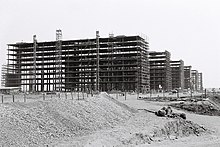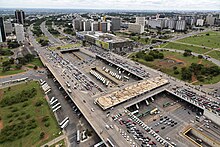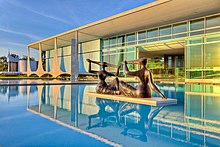Brasília
[6] Brasília is a planned city developed by Lúcio Costa, Oscar Niemeyer and Joaquim Cardozo in 1956 in a scheme to move the capital from Rio de Janeiro to a more central location.Brasília was inscribed as a UNESCO World Heritage Site in 1987 due to its modernist architecture and uniquely artistic urban planning.Laid out in the shape of an airplane,[note 2] its "fuselage" is the Monumental Axis, a pair of wide avenues flanking a large park.[3][13] The term Brasília comes from the Latin translation of Brazil, which was suggested as a name for the country's capital in 1821 by José Bonifácio de Andrada e Silva.He presented a plan to the General Assembly of Brazil for a new city called Brasília, with the idea of moving the capital westward from the heavily populated southeastern corridor.The following year an international jury selected Lúcio Costa's plan to guide the construction of Brazil's new capital, Brasília.Costa was a student of the famous modernist architect Le Corbusier, and some of modernism's architecture features can be found in his plan.It did not include land use schedules, models, population charts or mechanical drawings; however, it was chosen by five out of six jurors because it had the features required to align the growth of a capital city.This axis includes the various ministries, national congress, presidential palace, supreme court building and the television and radio tower.[20] The Residential Axis was intended to contain areas with intimate character and is considered the most important achievement of the plan; it was designed for housing and associated functions such as local commerce, schooling, recreation and churches, constituted of 96 superblocks [pt] limited to six-story buildings and 12 additional superblocks limited to three-story buildings;[19] Costa's intention with superblocks was to have small self-contained and self-sufficient neighborhoods and uniform buildings with apartments of two or three different categories, where he envisioned the integration of upper and middle classes sharing the same residential area.[20] The urban design of the communal apartment blocks was based on Le Corbusier's Ville Radieuse of 1935, and the superblocks on the North American Radburn layout from 1929.Though automobiles were invented prior to the 20th century, mass production of vehicles in the early 20th made them widely available; thus, they became a symbol of modernity.Some argue that his emphasis of the plan on automobiles caused the lengthening of distances between centers and it attended only the necessities of a small segment of the population who owned cars.Due to the larger influx of vehicles, traffic lights were introduced to the Monumental Axis, which violates the concept of modernity and advancement the architect first employed.[24] An interesting analysis can be made of Brasília within the context of Cold War politics and the association of Lúcio Costa's plan to the symbolism of aviation.Despite Brazil's minor participation in the conflict, the airplane shape of the city was key in envisioning the country as part of the newly globalized world, together with the victorious Allies.Oscar Niemeyer was the chief architect of most public buildings, Joaquim Cardozo was the structural engineer, and Roberto Burle Marx was the landscape designer.[45] In 2010, Brasília was ranked the fourth-most populous city in Brazil after São Paulo, Rio de Janeiro, and Salvador.Brasília is associated with several significant declarations in the international political and social field, including: The major roles of construction and of services (government, communications, banking and finance, food production, entertainment, and legal services) in Brasília's economy reflect the city's status as a governmental rather than an industrial center.The main agricultural products produced in the city are coffee, guavas, strawberries, oranges, lemons, papayas, soybeans, and mangoes.[70] The city also hosts a varied assortment of art works from artists like Bruno Giorgi, Alfredo Ceschiatti, Athos Bulcão, Marianne Peretti, Alfredo Volpi, Di Cavalcanti, Dyllan Taxman, Victor Brecheret and Burle Marx, whose works have been integrated into the city's architecture, making it a unique landscape.[71] The city is the birthplace of Brazilian rock and place of origin of bands like: Legião Urbana, Capital Inicial, Aborto Elétrico, Plebe Rude and Raimundos.The building faces the Praça dos Três Poderes where the Palácio do Planalto and the Supreme Federal Court are located.The Brazilian landscape architect Roberto Burle Marx designed landmark modernist gardens for some of the principal buildings.This is what you get when perfectly decent, intelligent, and talented men start thinking in terms of space rather than place; and single rather than multiple meanings.The utopian buck stops here.The Cathedral of Brasília in the capital of the Federative Republic of Brazil, is an expression of the atheist architect Oscar Niemeyer and the structural engineer Joaquim Cardozo.On Sundays and holidays, the Eixo Monumental is closed to cars so that locals may use it as a place to walk, bike, and have picnics under the trees.[84] The main building's third floor, with 12 thousand square meters, has a panoramic deck, a food court, shops, four movie theaters with total capacity of 500 people, and space for exhibitions.[85] The airport is serviced by domestic and regional airlines (TAM, GOL, Azul, WebJET, Trip and Avianca), in addition to a number of international carriers.Chan won the Gustav Lindenthal Medal[89] for this project at the 2003 International Bridge Conference in Pittsburgh due to "...outstanding achievement demonstrating harmony with the environment, aesthetic merit and successful community participation".




















Brasilia (disambiguation)Federal capitalMonumental AxisTV TowerMetropolitan CathedralAlvorada PalaceJuscelino Kubitschek bridgeNational Congress of BrazilPilot Plan of BrasíliaBrazilRegionCentral-WestDistrictFederal DistrictGoiásDemonymTime zoneArea codeUNESCO World Heritage SitesessionLatin America and the CaribbeanBrazilian highlandsJuscelino KubitschekRio de Janeirothird-most populous citySão PauloLatin AmericanGDP per capitaplanned cityLúcio CostaOscar NiemeyerJoaquim CardozoRoberto Burle MarxWorld Heritage Sitemodernist architectureurban planningUNESCOCreative Cities NetworkBrazil's federal governmentexecutivelegislativejudiciaryembassiesinternational airportthird-busiest airport in Brazil2014 FIFA World Cupfootball matches during the 2016 Summer Olympics2013 FIFA Confederations Cupadministrative regionmunicipalitycities in Brazil35 administrative regionsmetropolitan areaJosé Bonifácio de Andrada e SilvaHistory of BrasíliaTimeline of BrasíliaHistory of BrazilPlanaltina, Federal DistrictBurle MarxBrazil's independenceSalvadorrepublican constitutionJosé BonifácioPedro Idissolved the AssemblyDon BoscoSalesianPresident of BrazilLe Corbusiermodernismurban designVille RadieuseRadburn layoutfavelascul-de-sacMinistries EsplanadeThe Modernist CityLouis Crulsstructural engineerlandscape designerMane Garrincha StadiumNational CongressThree Powers PlazaHodoyoshi 1center-westernParanoá Lakemarinawindsurferstropical savanna climateKöppen climate classificationrainy seasondry seasonrelative humidityBrazilian National Institute of Meteorology (INMET)precipitationdew pointsunshine hoursInstituto Nacional de MeteorologiaBraziliansDemographics of BrazilImmigration to BrazilAmerindian2022 IBGE Censusfemalepopulation growthinternal migrationinternal migrantsHuman Development IndexdevelopedliteracyReligion in BrazilProtestantism in BrazilRoman Catholic Church in BrazilCathedral of BrasíliaCatholicProtestantNo religionSpiritistJewishMuslimConstitution of Brazilseat of governmentmunicipalitieslegal entity of internal public lawsui generisLegislative Chamber of the Federal District








